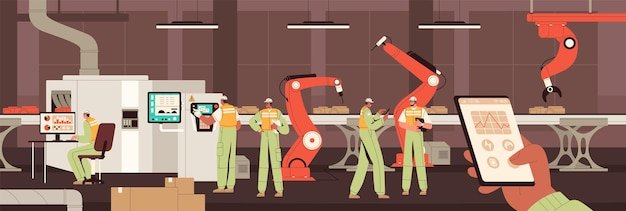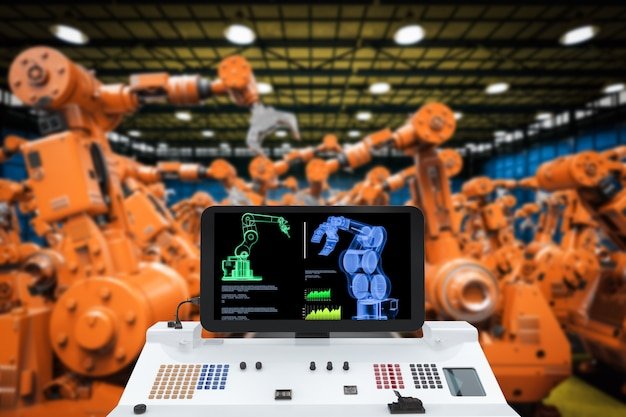Investing in US Manufacturing: Robotics and Automation Opportunities

The resurgence of US manufacturing, driven by advancements in robotics and automation, presents significant investment opportunities for those looking to capitalize on technological advancements and shifting economic landscapes.
The American manufacturing sector is experiencing a renaissance, fueled by technological innovation and strategic investments. This resurgence is particularly evident in the adoption of robotics and automation, creating fertile ground for investment opportunities.
The Current State of US Manufacturing
The manufacturing landscape in the United States is undergoing a significant transformation. Once perceived as a declining sector, US manufacturing is now experiencing a resurgence, driven by technological advancements, reshoring initiatives, and a renewed focus on domestic production.
Several factors contribute to this revitalization. Increased labor costs in overseas markets, coupled with advancements in automation technologies, are making US-based manufacturing more competitive. Additionally, government policies and incentives aimed at promoting domestic production are further fueling this trend.
Key Drivers of Manufacturing Growth
Understanding the key drivers behind the growth of US manufacturing is essential for identifying investment opportunities.
- Technological Innovation: The integration of robotics, artificial intelligence (AI), and advanced materials is revolutionizing manufacturing processes, enhancing efficiency, and reducing costs.
- Reshoring Initiatives: Many companies are bringing manufacturing operations back to the US to reduce supply chain vulnerabilities and benefit from a skilled workforce and advanced infrastructure.
- Government Support: Federal and state governments are offering tax incentives, grants, and other forms of support to encourage domestic manufacturing and create jobs.
The integration of these factors has catalyzed a shift toward smarter, more agile manufacturing processes, driving increased productivity and profitability.
In conclusion, the current state of US manufacturing presents a compelling narrative of revitalization and growth. By understanding the drivers and dynamics shaping this sector, investors can identify valuable opportunities within the burgeoning robotics and automation landscape.
Robotics and Automation: The Core of the Resurgence
Robotics and automation are no longer futuristic concepts; they are the cornerstone of the modern US manufacturing revival. These technologies are transforming factories and production lines, enabling greater efficiency, precision, and scalability.
The adoption of robotics and automation is reshaping manufacturing operations across various industries, from automotive and aerospace to electronics and consumer goods. These technologies are not just replacing human labor; they are augmenting it, enabling workers to focus on higher-value tasks and driving overall productivity gains.

Benefits of Robotics and Automation
The benefits of integrating robotics and automation into manufacturing processes are multifaceted and profound.
- Increased Efficiency: Robots can operate 24/7 without breaks, significantly increasing production output.
- Improved Precision: Automated systems ensure consistent quality and reduce the risk of errors, leading to higher levels of customer satisfaction.
- Reduced Costs: While initial investment costs may be significant, robotics and automation can lead to long-term cost savings through reduced labor, waste, and downtime.
These benefits collectively contribute to a more competitive and resilient manufacturing sector, positioning US companies for sustained growth and success.
In summary, robotics and automation are the fundamental enablers of the US manufacturing resurgence. By harnessing the power of these technologies, manufacturers can optimize their operations, drive innovation, and strengthen their position in the global marketplace.
Investment Opportunities in Robotics
The rise of robotics in US manufacturing has created a wealth of investment opportunities across various segments, from robot manufacturers to software developers and system integrators.
Investors can capitalize on this trend by targeting companies that specialize in designing, developing, and deploying robotic solutions for manufacturing applications. These opportunities can range from publicly traded corporations to smaller, innovative startups that are disrupting the industry with cutting-edge technologies.
Areas of Robotic Investment
Identifying specific areas of robotic investment can help investors tailor their strategies and maximize returns.
- Robot Manufacturers: Companies that produce industrial robots, collaborative robots (cobots), and other automation equipment.
- Software Developers: Firms that create software platforms for robot programming, simulation, and control.
- System Integrators: Businesses that design, install, and maintain robotic systems for manufacturers.
These areas represent distinct yet interconnected segments of the robotics ecosystem, each offering unique investment potential.

In conclusion, the investment landscape in robotics is diverse and dynamic, offering abundant opportunities for investors seeking exposure to the US manufacturing resurgence. By focusing on specific areas and identifying promising companies, investors can position themselves to benefit from the continued growth and innovation in this sector.
Investment Opportunities in Automation
Beyond robotics, automation encompasses a broader range of technologies and systems that are transforming US manufacturing. These include programmable logic controllers (PLCs), sensors, machine vision systems, and other advanced control technologies.
Investing in automation provides opportunities to support businesses that enhance manufacturing processes by optimizing supply chains, improving quality control, and streamlining production flows. These companies are crucial in shaping more dynamic and cost-effective production models.
Types of automation investments
Exploring the various types of automation investments will enable investors to create a well rounded investment portfolio.
- PLCs and Control Systems: Companies that manufacture and supply programmable logic controllers (PLCs) and other control systems for automating manufacturing processes.
- Sensors and Machine Vision: Firms that develop and produce sensors, cameras, and machine vision systems for quality control, inspection, and process monitoring.
- Supply Chain Management Software: Businesses that provide software solutions for optimizing supply chain logistics, inventory management, and demand forecasting.
The integration and application of these technologies are essential for smart manufacturing initiatives across various industries.
In summary, automation offers a comprehensive range of investment opportunities within US manufacturing, including PLCs, sensors, and supply chain software. By investing in automation, investors can promote more efficient, resilient, and innovative manufacturing structures in the United States.
Identifying Promising Investment Targets
Selecting the correct investments requires a nuanced evaluation of various companies. Investors should explore financial health, uniqueness in current market positions, and possibilities for expansion.
By performing a well-rounded assessment, investors can accurately assess the capacity for long-term expansion and profitability throughout different markets.
Key Metrics to Assess
When searching for potential investment, there are some key metrics to assess.
- Financial Performance: Evaluate the company’s revenue growth, profit margins, and cash flow to assess its financial stability and growth potential.
- Market Position: Analyze the company’s market share, competitive landscape, and differentiation to determine its ability to capture and retain customers.
- Technological Innovation: Assess the company’s investment in research and development, patent portfolio, and ability to stay ahead of technological trends.
By utilizing these metrics, investors can make very well informed choices, resulting in greater returns over time.
In summary, discovering guarantee promising avenues for investment across US manufacturing demands that assessment of the financial status, current market standing, and developments to generate a good selection for potential prospects.
Potential Risks and Challenges
While the resurgence of US manufacturing presents exciting investment opportunities, it is crucial to acknowledge the potential risks and challenges associated with this sector. These include economic fluctuations, technological transformations and regulatory changes.
Being informed of these issues allows for an investor to accurately foresee and lessen the impact of any market downturn, ensuring investment strategies remain flexible and aligned with overall market stability.
Navigating Potential Risks
Being aware of the many emerging risks and obstacles could effectively mitigate any challenges that may arrise. Awareness allows for the opportunity to develop a well planned mitigation strategy.
- Economic Fluctuations: Downturns in the global economy can negatively impact manufacturing demand, leading to reduced revenues and profitability.
- Technological Disruption: Rapid advancements in technology can render existing robotic and automation systems obsolete, requiring companies to invest in new technologies to stay competitive.
- Regulatory Changes: Changes in government regulations, trade policies, and environmental standards can impact manufacturing costs and competitiveness.
Having a working understanding of market volatility is fundamental to guaranteeing capital preservation and growth, especially when there could be large market shifts.
In short, capitalizing on the resurgence of US manufacturing involves thoroughly evaluating challenges, such as economic, technological and regulatory changes. Remaining vigilant, performing active risk management, and remaining flexible empowers investors. Awareness enables investors to protect the stability and expansion of investment holdings.
| Key Point | Brief Description |
|---|---|
| 📈 US Manufacturing Resurgence | Driven by tech advancements, reshoring, and government support. |
| 🤖 Robotics & Automation | Core to improving efficiency, precision, and lowering costs. |
| 💰 Investment Areas | In robot manufacturers, software developers, and system integrators. |
| ⚠️ Potential Risks | Include economic fluctuations, tech disruptions, and regulatory changes. |
Frequently Asked Questions
▼
The resurgence is driven by factors like increased labor costs overseas, technological advancements, reshoring initiatives, and government support that collectively make US-based manufacturing more competitive.
▼
Robotics and automation increase efficiency through 24/7 operation, improve precision for consistent quality, and reduce long-term costs by minimizing labor, waste, and downtime.
▼
Key investment areas include robot manufacturers, software developers creating robot programming platforms, and system integrators that design and maintain robotic systems for manufacturers.
▼
Target companies include those manufacturing PLCs, developing sensors and machine vision systems, and providing supply chain management software to optimize manufacturing processes.
▼
The primary risks encompass economic fluctuations affecting demand, technological disruptions rendering systems obsolete, and regulatory changes impacting costs and competitiveness in the manufacturing sector.
Conclusion
The revitalization of the United States manufacturing, powered by progress in robotics and automation, provides noteworthy possibilities for strategic financial backing. By delving into technological innovations, addressing potential hurdles, and adjusting dynamically to market shifts, investors may gain substantial returns. This sector is creating openings for those trying to boost output and modernize traditional manufacturing methods across the United States.





